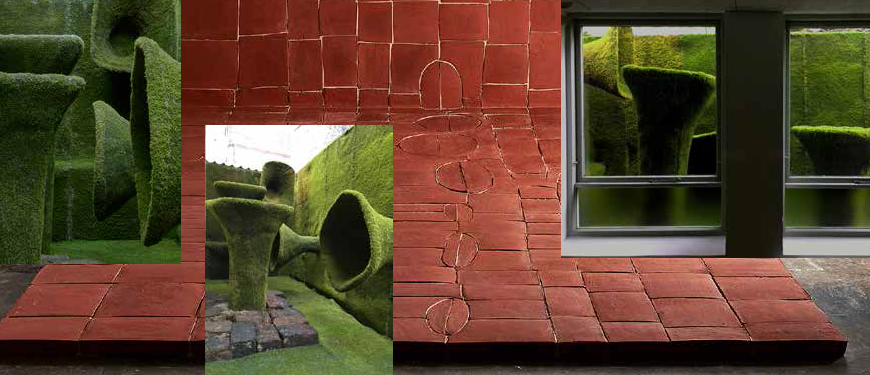As an artist, I work with nature and soil from many angles: physical, sensory, mythical, scientific, sustainable. What do nature and the colour green mean to us; what does nature do to us; where is nature headed and what is man's relationship with nature? Physically, mentally, ideologically, historically, architecturally and mythologically, depending on whether you live in the city or in the countryside.
The enclosed green light well: Inside-Outside (It's About Time)
Inside-Outside is a monumental and sensually artificially landscaped ‘forest’ or biotope. The biotope must not be stepped on for 10-20 years. Until then, it may only be observed from the outside and from above. This will allow people to watch the area changing over time, quietly and at its own pace. A habitat for various moss species, the project is a biotope that is off-limits to humans. As for the title ‘Inside-Outside’, on the one hand I want to point to the forest/biotope as a poetic alternate reality people can lose themselves in – a mental inner breathing space. On the other hand, I wanted to call attention to the manner in which we, as humans, are contributing to the changes of nature, to its decline. Overall, Inside-Outside is a piece of nature that is allowed to remain untouched, allowing us to witness what happens and what it means when nature is allowed to evolve without intervention.
The moss creation will remain untouched for many years as a kind of manifesto or monument to time and a tribute to the prolonged sensation of time and space of thought, neither of which is prioritised all that much in today's urban development and architectural policy. I want to create a landscape that connects us to the world of biological processes in which we exist as human beings and as a society.
The forest consists of a series of tubular vertical and horizontal growths – the tallest of which stands at 7 metres – which form an area that mimics a dense tall forest or a hilly, pristine landscape. The work appears differently, depending on which of the two floors you are standing. The forest can thus be viewed from above and from the side and while walking around it. The base of the room is constructed from compressed Sphagnum and moss grown on thick felt. Due to the manner in which they are carved out, the pieces of compressed Sphagnum are perfectly suited as building blocks for the base construction of a universe in the display case. Over time, the Sphagnum will be redefined and interact with the moss. Moss is one of the only things that can grow on Sphagnum. Like moss, Sphagnum has a long lifespan and isn’t susceptible to mould. The forest's tubular shapes and floor are covered by a large number of mosses from various countries and regions and which are grown differently, e.g. on peat, on Sphagnum, in bogs etc. An example of this is the peat bog, which is disappearing in Denmark because bogs and wetlands are in decline in nature. Being able to hold up to 20 times as much water as their dry weight, peat bogs are also being used to combat issues with water and flooding in lower-lying areas. The mosses are of great importance for the ecology. Not least in our Nordic sister countries, where they are important pioneer plants on rocks and in coniferous forests. In Denmark, the mosses are also of great importance for the microclimate and a large number of insects as well as wildlife. A forest with a lot of moss is often far more rich in species than a forest where the mosses do not thrive.
The open red light well: Circle – fractured surface
The westward light well is a red tile garden. The bricks in the light well will be a combination of ready-made and handmade bricks. The idea behind the space is that you can pass through it and quickly get to the other wing while getting some fresh air. The outdoor space is thought of as a natural meeting place during breaks or between classes. The light well will feature two circles, one of which may serve as a seating area. The other circle will be the starting point for a sculpture that breaks through the surface. The sculpture will have several surfaces that people can sit on. A tree is planned in the well. To make the tree visible on the second level, it will be planted in a kind of rising chimney.
The circle is one of the oldest and most significant symbols and has been used throughout art history, philosophy, church history and mathematics, e.g. as a symbol of the absolute, the eternal and the infinite – that which can neither be defined, described nor grasped. The circle is in fact boundless, because its circumference represents only the limits of man's perception of both physical and inner space. My work with the circle is based on this, but also combined with my many years of work with and fascination for the moss' cell structures and cell divisions. The circle as a symbol of perfection is broken when viewing is as a kind of cell that never achieves the circular shape during cell divisions, but instead consists of divisions which can assume shapes with four, five or six edges. My work with the circle is thus based on the combination of a kind of disorder in perfection.



